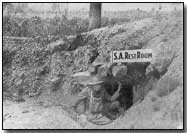Encyclopedia - Dug-Out
 Dug-outs, usually sited close
to the trench line - often within or below the trench wall - were used as a form
of underground shelter and rest for both troops and officers.
Occupants of dug-outs would eat their meals, arrange meetings and
often make their bed there.
Dug-outs, usually sited close
to the trench line - often within or below the trench wall - were used as a form
of underground shelter and rest for both troops and officers.
Occupants of dug-outs would eat their meals, arrange meetings and
often make their bed there.
Dug-outs were considered much safer than resting or lying in the open since they afforded some form of protection against not only the weather but, far more critically, from enemy shell-fire. However it was not unusual for direct shell hits to burrow through to dug-outs, killing or maiming all occupants.
Dug-outs generally took one of three forms. Those which enabled one, possibly two, men to rest in some discomfort within the trench wall were termed 'cubby-holes' or 'funk-holes'. Propped up by wooden posts and corrugated iron and somewhat deeper, 'Shelters' gave protection to a rather larger number of men.
However the best form of dug-out were the 'Deep' variety and were almost exclusively used by senior officers. Deep dug-outs were entered via a stairway stretching up to 10 feet below ground. Within the dug-out were housed one or more rooms used for meetings as well as rest and relaxation. Electric lights were often installed in such dug-outs as was wire bedding.
The entrance to the dugout would often be draped with a gas curtain to keep out enemy gas. Such protection could work both ways however; a soldier who entered the dug-out in the aftermath of a gas attack could carry the remnants of gas on his boots. The gas curtain would then prevent the gas escaping; it was not uncommon for all men in a dug-out to be gassed while sleeping as the result of gas inadvertently brought in by a colleague.
Photograph courtesy of Photos of the Great War website
A "blimp" was a word applied to an observation balloon.
- Did you know?
